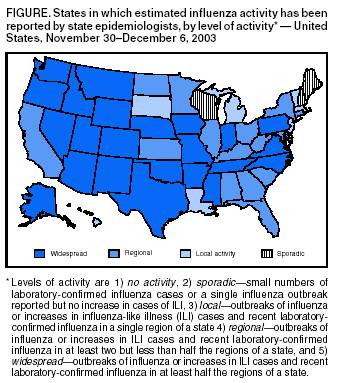





3853 Atlantic Ave.

|
Click here |
Flu Spreads Further...And CDC Says Severe Pediatric Illness & Deaths Underscore Severe Consequences in Kids; Read CDC's Latest Update
(Dec. 11, 2003) -- The Centers for Disease Control (CDC) has issued a Health Alert Network message, updating flu activity in weekly Morbidity and Mortality Weekly Report.
The CDC warns that "reports of severe pediatric illnesses and deaths underscore the severe consequences that influenza infections can cause in children...Although the pathophysiology of sudden deaths associated with influenza in children is unknown, atypical symptoms (e.g., abdominal pain, absence of fever, and mild respiratory symptoms) have been reported. Encephalopathy is another severe and potentially In the public interest, LBReport.com posts extended excerpts of the CDC update below...as well as links to CDC web site pages on the flu.
CDC defines "regional" outbreaks as "outbreaks of influenze or increases in ILI [influenza like illness] cases and recent CDC did not indicate what regions of CA were affected.
The CDC update stated in pertinent part: Cases of sudden death associated with influenza in previously healthy children also were reported in the United States during the 2002--03 season...Although the pathophysiology of sudden deaths associated with influenza in children is unknown, atypical symptoms (e.g., abdominal pain, absence of fever, and mild respiratory symptoms) have been reported.
Encephalopathy is another severe and potentially under-recognized complication of influenza in children. One case so far this season has resulted in the death of a patient. Patients might report high fevers, seizures, headaches, abnormal mental status, and/or confusion and do not always exhibit classic influenza symptoms. Cases have been reported among young children and school-aged children, including adolescents...
CDC has received reports of severe complications of influenza occurring in young infants, school-age children, and adolescents. Complications have included encephalopathy, seizures, dehydration with severe hypotension, respiratory failure requiring mechanical ventilation, and secondary bacterial pneumonia, including necrotizing pneumonia with community-associated methicillin-resistant Staphylococcus aureus (CA-MRSA). Three deaths (an infant aged 20 months with underlying reactive airways disease, a previously healthy infant aged 22 months, and a previously healthy child aged 16 years) have been associated with secondary pneumonia caused by CA-MRSA. Other influenza-related deaths not related to CA-MRSA in children have occurred. Fatal cases reported to CDC are being investigated by local and state health authorities. Laboratory testing has confirmed influenza A virus infection in these fatal cases; antigenic characterization is pending. The vaccination status of the majority of the deceased children has not been determined. CDC's update said pregnant women are at higher risk than nonpregnant women for having complications secondary to influenza and "pregnant women who will be in their second or third trimester during influenza season should be vaccinated against influenza."
CDC said it had characterized antigenically 215 influenza viruses collected and submitted by U.S. labs since October 1. 212 were influenza A (H3N2) viruses...of which 54 (25%) were similar to the vaccine strain A/Panama/2007/99 (H3N2)...while 158 (75%) were similar antigenically to A/Fujian/411/2002, a drift variant of A/Panama/2007/99.
So how effective is the flu vaccine expected to be this year?
CDC said "the unusually high and persistent demand for vaccine have resulted in a decreasing supply of trivalent inactivated vaccine. Emphasis should be placed on vaccinating persons at high risk for complications from influenza, including healthy children aged CDC adds:
CDC's web site currently includes the following recommendations for influenza prevention:
Hygiene
Good respiratory hygiene should be encouraged, including cleaning of hands, and staying at home when symptomatic with fever and respiratory illness.
Medication
Antiviral medications with specific activity against influenza A viruses should be considered either for treatment or chemoprophylaxis for influenza A, especially in persons at high risk for complications from influenza. [see text above] For further details and updates:
|
